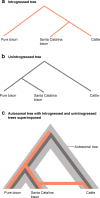Conservation of biodiversity in the genomics era
- PMID: 30205843
- PMCID: PMC6131752
- DOI: 10.1186/s13059-018-1520-3
Conservation of biodiversity in the genomics era
Abstract
"Conservation genomics" encompasses the idea that genome-scale data will improve the capacity of resource managers to protect species. Although genetic approaches have long been used in conservation research, it has only recently become tractable to generate genome-wide data at a scale that is useful for conservation. In this Review, we discuss how genome-scale data can inform species delineation in the face of admixture, facilitate evolution through the identification of adaptive alleles, and enhance evolutionary rescue based on genomic patterns of inbreeding. As genomic approaches become more widely adopted in conservation, we expect that they will have a positive impact on management and policy decisions.
Conflict of interest statement
Ethics approval and consent to participate
Not applicable.
Competing interests
The authors declare that they have no competing interests.
Publisher’s Note
Springer Nature remains neutral with regard to jurisdictional claims in published maps and institutional affiliations.
Figures





References
Publication types
MeSH terms
Grants and funding
LinkOut - more resources
Full Text Sources
Other Literature Sources
Research Materials

